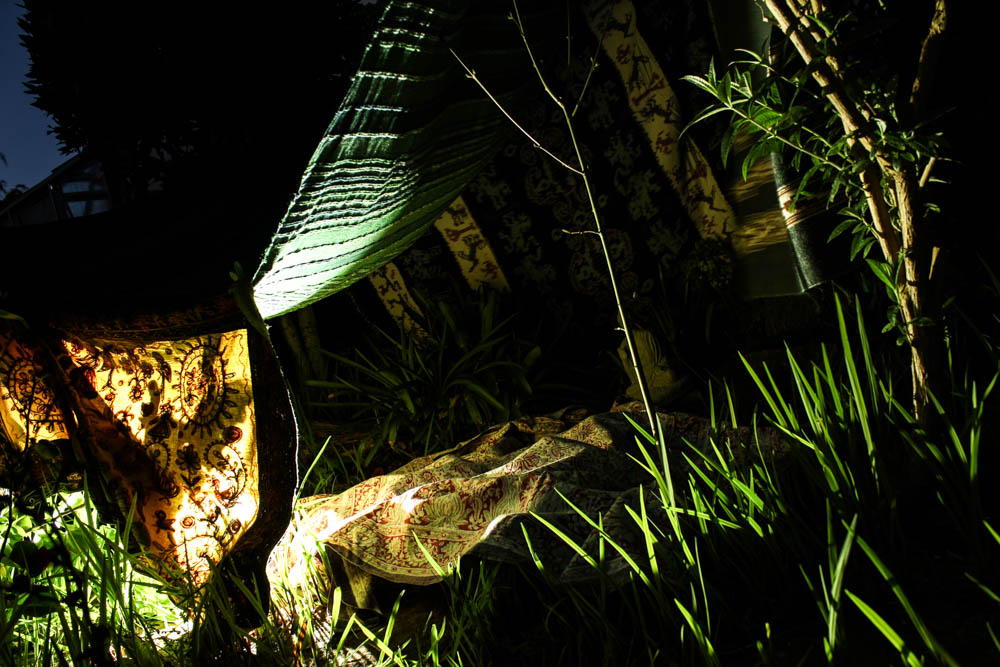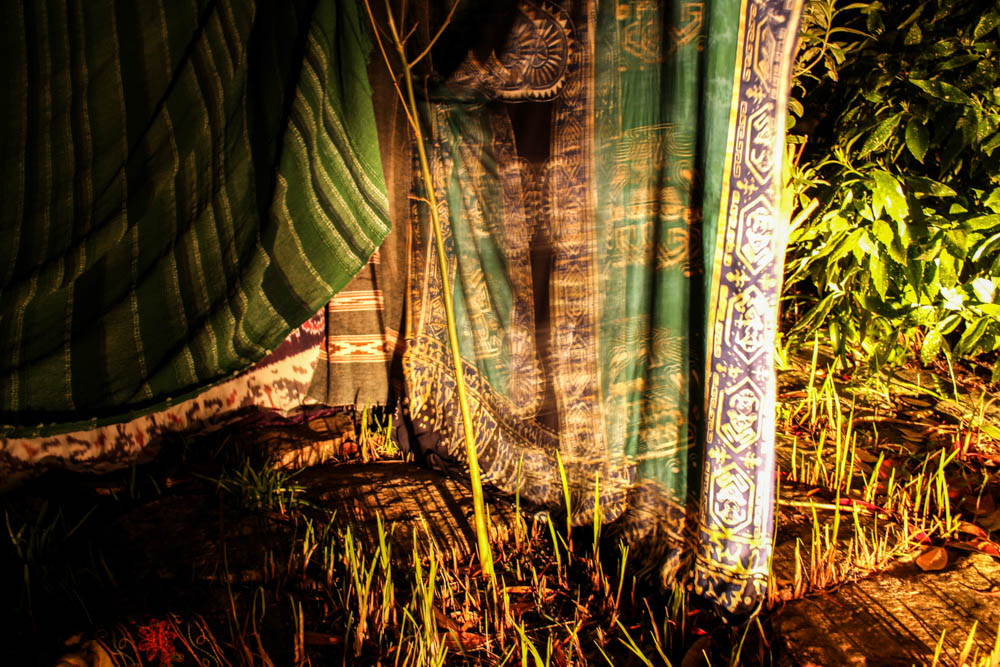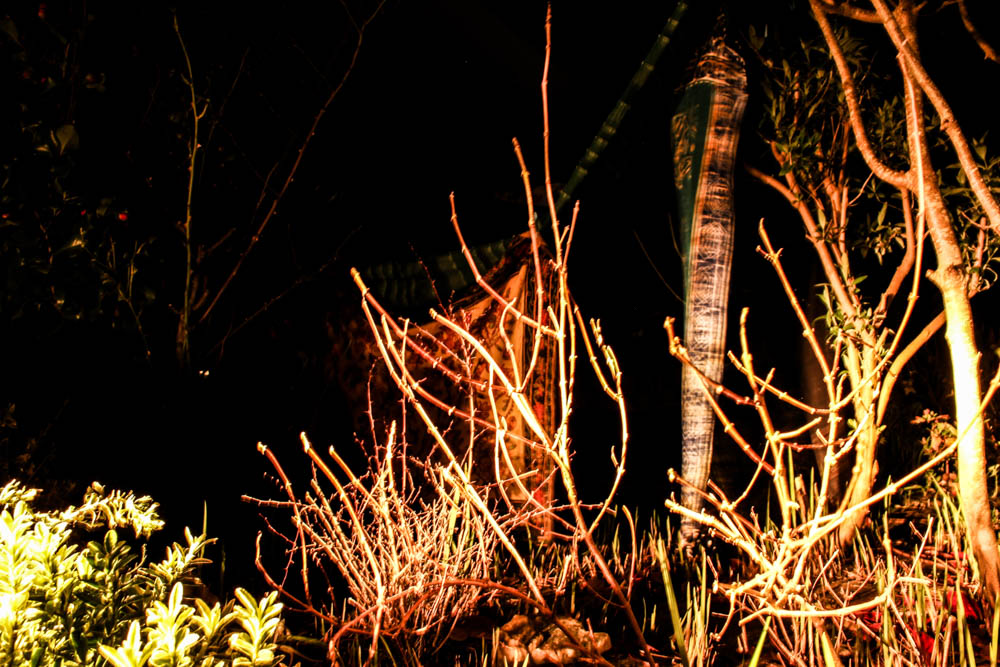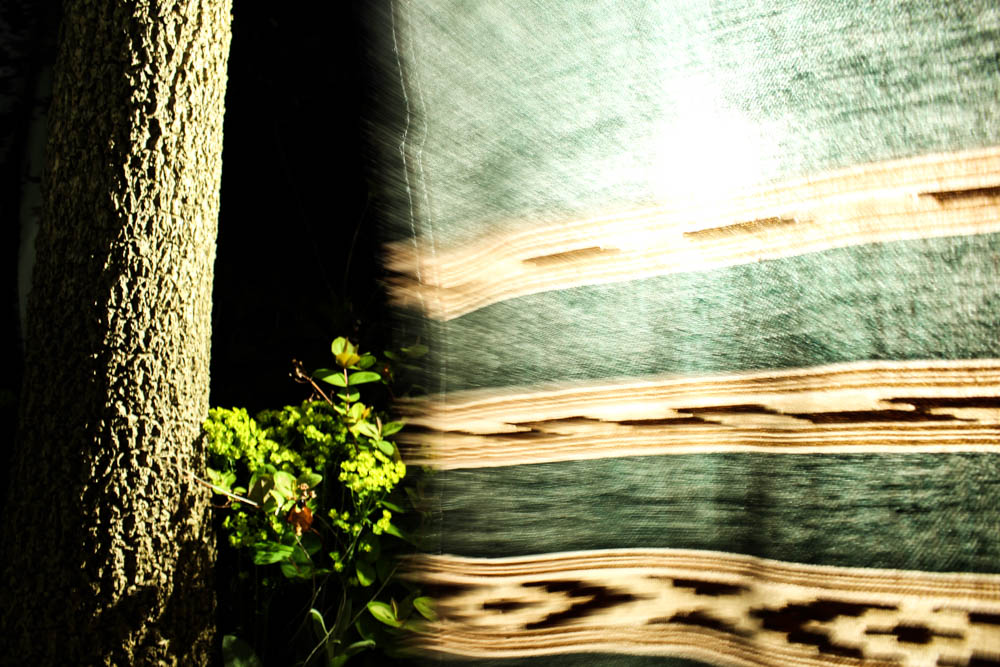This photo shoot was actually the first night one which i did. I had to however repeat the shoot and learn from trial and error. The first time i used a car’s headlight. As you can see below the light was very yellow and i also wasn’t able to move the light around much to position it where i wanted it. I did manage to get some interesting photographs but i then repeated the shoot with my portable light as the light in these images is a white light and therefore looks less artificial.
In these images as i had to use such a low shutter speed to capture the images many of them have the blurr of the movement of blankets. The dens i had photographed before this were sturdy and didn’t have hanging material which could move in the wind. For some of the photographs this movement works really well in conveying an eerie impression of the den but i would have liked to have been able to take some photographs in which there was no blurr. This was pretty much impossible however as the slightest movement caused a blurr.
Overall i think my other night time den shoots have gone better, i think this den is defiantly the least impressive of all my others in both photo shoots.
I do quite like this images even though the light is fairly yellow. I particularly like the images above and below which focus on the branches and trees in front of the den which become like silhouettes with the light shinning directly onto them. The yellowness of the light in these images actually make the images appear more creepy as they contrast better with the darkness of the background.


The below images are the second shoot i did in which i used the white light. The difference in the images is instantly noticeable as the lights are such different colours. The white light also appears more powerful and far reaching and so more of the den is illuminated in the below images. I do like certain images from both shoots, even though they are completely contrasting due to the light.


The above images and below images very interestingly play with the blur of the blankets in the wind. The impression of the photographs is that as the light is behind the blurred blanket, that it is rushing forward towards the camera and has a presence as the light suggests life. The light in both photographs is intense and shines from directly behind the blanket in a circle. The rest of the image is slightly illuminated, the tree and some plants but the background is an intense black which only exaggerates the whiteness of the blanket further. The blanket is also just blurred enough to suggest a fast pace of movement but without being too fast to become transparent. The image is composed to consider angles, the blanket covering most of the frame but its straight lines being complimented by the straight lines of the tree also.
The below image is slightly different as it shows more of the den, having the tree flanked on both sides by different blankets. The image is also illuminated slightly differently so that it included the light shinning onto the plants and also the light shines onto both blankets.


The above image interestingly plays with having elements of the frame in black darkness and then having other elements of the frame in bright light. The light source in this image comes from the left hand side of the frame, an intense bright white light that illuminates the plants closest too it and casts enough light to also illuminate the blanket. The blanket in this image is a complete blur, the pattern just about distinguishable. The direction of the blur suggests that it is blowing away from the light source. The whole image is taken at a slight angle . The darkest part of the image is actually the foreground where the plant becomes a shadow from the lack of light.

The above image plays with the light casting shadows. I placed the light behind the blanket like in so many of my other shoots and in this image it worked really well as it cast shadows. The light leaks out from underneath the blanket, spilling into the foreground. The image is composed according to the rule of thirds, the light to the right hand side of the frame, the left hand side of the frame almost in complete black darkness from the lack of light. I quite like how only a very small portion of the image is lit up and the rest is in darkness. The plants become silhouetted against the bright white light.









Lots of good work – I particularly like the images at night which add another dimension.
However, your meticulous method of recording every den build and constructed can be used as part of you presentation
Are we still thinking about a photobook?
I also think you need to explore ways of presenting images onto fabrics use to build the den or perhaps create an den as your final installation int the exam – i.e build a den then photograph the process, us the den to exhibit your older images made now, maybe make a film that plays, so it becomes a child’s dreamlike escape.
Have a look at Tracy Emin’s tent (different connotations but you get the idea..)
Look also at other who creates rooms/ installation as exhibits
See work by
Lorenzo Venturi: Dalston Anatomy
http://www.felicityhammond.com
Boyd Webb – who uses fabrics etc to construct (born 1947) is a New Zealand-born visual artist who works in the United Kingdom. Initially he worked as a sculptor, making life casts of people in fibreglass and arranging them into scenes. He eventually turned to photography and his early work played with ideas of the real and the imagined. Through mysterious and elaborate compositions created using actors and complex sets built by the artist in his studio. In later years his focus shifted to a cool observational style, his work less theatrical and technique less elaborate.
Anne Hardy’s photographs picture depopulated rooms that suggest surreal fictions. Working in her studio, Hardy builds each of her sets entirely from scratch; a labour-intensive process of constructing an empty room, then developing its interior down to the most minute detail. Using the transient nature of photography, Hardy’s images withhold the actual experience of her environments, allowing our relationship with them to be in our imagination.